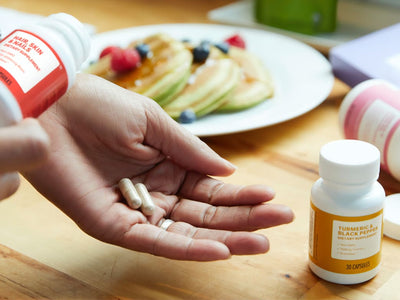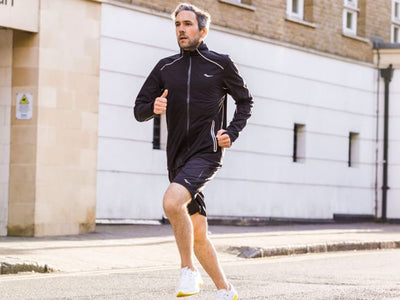The Benefits of a Colorful Diet with Anthocyanin-Rich Foods
Posted by Jim Applegate on

Go beyond the basic hues in your produce picks. The more colorful your fruits and veggies are, the better.
Eating colorful fruits and vegetables is good for you, but do you know why? Not only is each color the result of a different set of pigment-inducing compounds found in a particular food — for example, beta-carotene makes carrots look orange — but those same compounds are often responsible for some of your food’s most important health benefits.
In the case of foods from the blue/purple/dark red family, the common element is a series of compounds known as anthocyanins. And while you may not have an easy time pronouncing them, there are lots of good reasons for a fit-minded female to load up on foods rich in this powerful family of nutrients at the next trip to the grocery store.
What is an Anthocyanin?
They are part of a family of active compounds in food known as flavonoids. While blueberries are probably the most well-known anthocyanin-rich food, there are plenty of other sources too, ranging from red raspberries to purple eggplants. Depending on the pH level of the food, anthocyanins can range from red in acidic foods to purple with a neutral pH, and blue in basic foods. In general, any fruit, vegetable or legume (think beans) that have a deep red, purple or blue hue will contain some amount of anthocyanins, though some foods naturally contain more than others.
So how, exactly then do anthocyanins work the body? Researchers aren’t exactly sure yet. Some studies have even shown that very little is absorbed by the bloodstream, causing some to speculate that it is more than just the anthocyanins doing the work in our bodies. With that, there are also enough studies showing their potential health and fitness benefits, so it’s worth a closer look at these intensely colored foods.
Fights Inflammation
Anthocyanin-rich foods seem to be natural inflammation fighters, and that can be important for keeping numerous workout-sapping conditions, ranging from achy joints to asthma, under control. In a study published in the Journal of Nutrition, men who ate one purple potato per day over six weeks had reduced levels of whole-body inflammation and less DNA damage than men given an equal portion of white potatoes.
Controls Weight
Could anthocyanins actually help keep you lean? Studies have suggested that blueberry anthocyanins, in particular, may be able to help prevent the accumulation of body fat. One study published in the Journal of Agriculture and Food Chemistry discovered that mice placed on a high-fat diet gained no more body fat than mice on a low-fat diet, as long as they were given either blueberry juice or purified blueberry anthocyanins.
Improves Circulation
While cardiovascular disease might not be at the forefront of your mind, know this: a healthy heart helps to transport oxygen to working muscles, and anthocyanins may help keep the heart and circulatory system in top condition by relaxing blood vessels by triggering the release of the compound nitric oxide.
Bonus: Studies suggest that anthocyanin-rich blueberries protect the brain from aging, keeping you fit and sharp as time ticks by.
Fends Off Aging & Cancer
Anthocyanins are also natural antioxidants, which means they protect our cells from oxidative damage from the likes of ultraviolet light, pollution or the natural aging process. Anthocyanins may also prevent the growth of cancerous cell lines in the body: in one study, published in the Journal of Medicinal Food, an extract of anthocyanin-rich Concord grapes helped prevent cancerous damage to breast tissue.

Anthocyanin-Rich Foods
Any plant-based food that is blue, purple or deep red will likely contain some amount of anthocyanins. Here are some of our favorites:
Cranberries
Bitter they may be, but cranberries seem to be particularly beneficial for preventing unwanted bacteria from sticking to the cells of the urinary tract, keeping infections away. Watch out for sweetened cranberry cocktails, however — you’re better off to use a splash of the real stuff in sparkling water for an alcohol-free cocktail with dinner.
Tart Cherries
Like cranberries, tart cherries have a bit of zing, but it’s a taste you can get used to, especially when you see that this juice not only seems to reduce oxidative stress, a process that contributes to aging, but research suggests that it also reduces some symptoms of exercise-induced muscle damage after even the toughest workouts.
Red Cabbage
They’re chock-full of antioxidants, with very few calories, and science also suggests that cabbage family foods are particularly powerful breast cancer fighters.
Try: Sautéed shredded red cabbage with a chopped apple as a bold side-dish to your favorite protein source.
Blackberries
If you’re ready for a break from blueberries, blackberries are a great option. Nutritional winners for their anthocyanin content, blackberries are also low in calories (62 per cup) and high in fiber (eight grams per cup). Keep fresh or frozen blackberries on hand for a boost to yogurt, oatmeal, shakes and even cottage cheese.
Red Kidney Beans
Yes, anthocyanins are found in more foods than just berries. Red kidney beans are a must for leaning out as they’re packed with protein, filling fiber and disease-fighting antioxidants — a rare combination found in few other foods.
Try: Toss them into a chili, or mash them up with some cumin and garlic for a quick veggie dip.
Written by OxygenMag for Oxygen Magazine and legally licensed through the Matcha publisher network. Please direct all licensing questions to legal@getmatcha.com.








